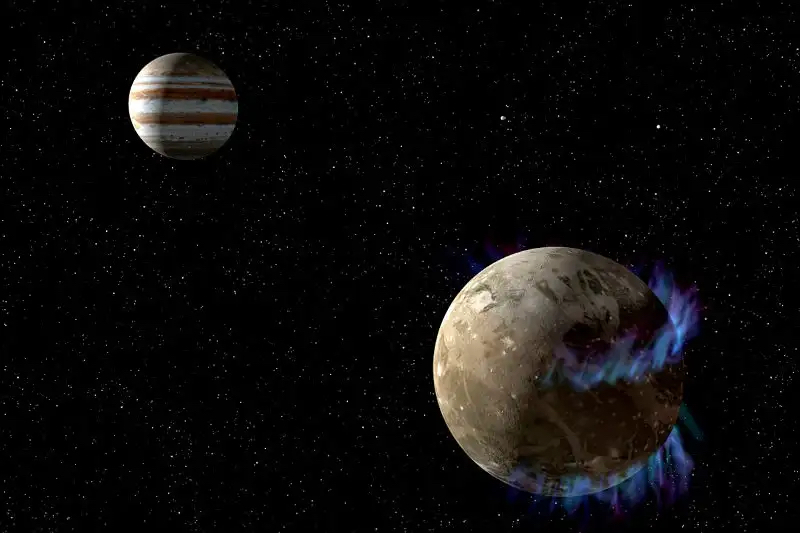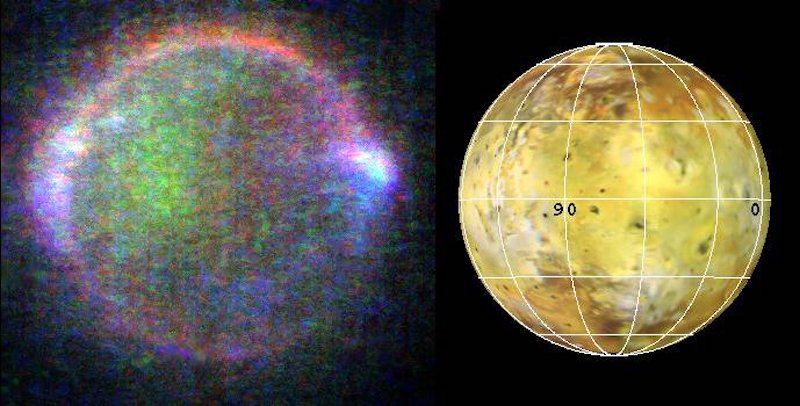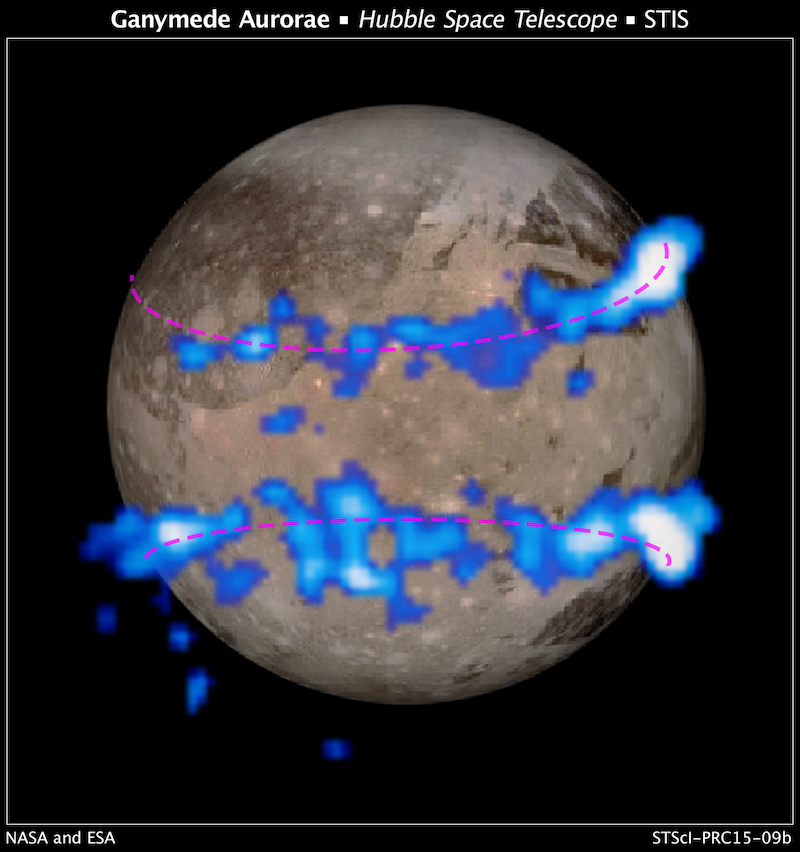
Like Earth, the giant planet Jupiter has auroras – what we call the northern or southern lights – in its upper atmosphere. And there are auroras on all four of Jupiter’s large Galilean moons, too. Previously, scientists had observed auroras on Jupiter’s moons primarily at ultraviolet wavelengths. But this month (February 16, 2023), astronomers from Caltech and Boston University said they’ve detected new auroras, in visible light, on Io, Europa, Ganymede and Callisto.
They made their observations with the W. M. Keck Observatory on Mauna Kea in Hawaii.
The Planetary Science Journal published two new peer-reviewed papers about the auroras on February 16, 2023. You can read the first here and second here.
Last chance to get a moon phase calendar! Only a few left. On sale now.
Visible-light auroras on Jupiter’s moons
The auroras are very faint. So how did the researchers detect them? Simply enough, they observed the moons while they were in Jupiter’s shadow. That way, sunlight that otherwise reflects off their surfaces didn’t interfere with the observations. Katherine de Kleer at Caltech, lead author of one of two new research papers, said:
These observations are tricky because in Jupiter’s shadow the moons are nearly invisible. The light emitted by their faint auroras is the only confirmation that we’ve even pointed the telescope at the right place.
To make these observations, astronomers used Keck Observatory’s High-Resolution Echelle Spectrometer (HIRES) as well as high-resolution spectrographs at the Large Binocular Telescope and Apache Point Observatory.
Same oxygen auroras as on Earth
Although the auroras on the four moons are generally fainter than those on Earth, they form much the same way. Ionization and excitation of particles in the extremely thin atmospheres produces the light displays. Those atmospheres are composed mostly of oxygen. Likewise, on Earth, oxygen and nitrogen both play a role in the formation of auroras.
However, while auroras on Earth are primarily greenish, the ones on Jupiter’s moons are reddish. The auroras on Ganymede and Europa show up fairly well in infrared light. At that wavelength, they’re a bit redder than the human eye can normally see.

Io’s volcanoes create colorful auroras
On Io, things get even more interesting. Generally speaking, its auroras are basically similar to those of the other moons. Io, however, is extremely volcanically active. It is, in fact, the most volcanically active body in the whole solar system. Salts like sodium chloride and potassium chloride in the volcanic plumes make Io’s auroras extra colorful. The sodium makes the auroras look yellowish-orange. In addition, Io has potassium-based auroras, not seen anywhere else in the solar system.
The different colors provide clues about the moons’ tenuous atmospheres. Kleer said:
The brightness of the different colors of aurora tell us what these moons’ atmospheres are likely made up of. We find that molecular oxygen, just like what we breathe here on Earth, is likely the main constituent of the icy moon atmospheres.

Auroras on Jupiter’s moons change brightness
In addition, the astronomers also noticed that the auroras on the four moons change in brightness. How does that happen? Basically, the auroras change in brightness as Jupiter itself rotates. That’s because Jupiter’s magnetic field is tilted, so the moons are sometimes more affected by the magnetic field and at other times less so. Three of the four moons – Io, Europa and Ganymede – orbit within Jupiter’s large and powerful magnetosphere. Also, as Jupiter rotates, there is a sharp transition between warmer sunlight and colder shadow. This also affects the brightness of the auroras, on Io in particular. Carl Schmidt at Boston University and lead author of the second paper said:
Io’s sodium becomes very faint within 15 minutes of entering Jupiter’s shadow, but it takes several hours to recover after it emerges into sunlight. These new characteristics are really insightful for understanding Io’s atmospheric chemistry. It’s neat that eclipses by Jupiter offer a natural experiment to learn how sunlight affects its atmosphere.
Auroral tails for Jupiter’s moons
In 2021, NASA Juno spacecraft mapped the auroral tails of the four moons in Jupiter’s atmosphere. Researchers said that the unique pattern of the moons’ auroral tails is likely caused by interactions between the upper layer of Jupiter’s atmosphere (the ionosphere) and Jupiter’s strong magnetosphere, as the moons move through Jupiter’s sky.
Additionally, the same three moons produce bright spots, or footprints, in Jupiter’s own auroras. The footprint itself is the main auroral emission, while the footprint tail is an extended series of fading dots trailing behind the footprint: auroral tails.
When it comes to auroras, Jupiter and its moons are a complex and dynamic system!
Bottom line: Astronomers have detected auroras on Jupiter’s Galilean moons in visible light wavelengths for the 1st time, using the Keck telescope in Hawaii and other telescopes.
Source: The Optical Aurorae of Europa, Ganymede and Callisto











